VAT Legislations and Tax Filing Requirements
VerifiedAdded on 2020/10/23
|13
|3789
|214
AI Summary
The report discusses VAT legislations and rules in the UK, including the importance of maintaining accurate records for VAT return filing. It highlights the penalties and fines associated with late or no returns and provides a summary of the progressions in VAT since its initiation.
Contribute Materials
Your contribution can guide someone’s learning journey. Share your
documents today.
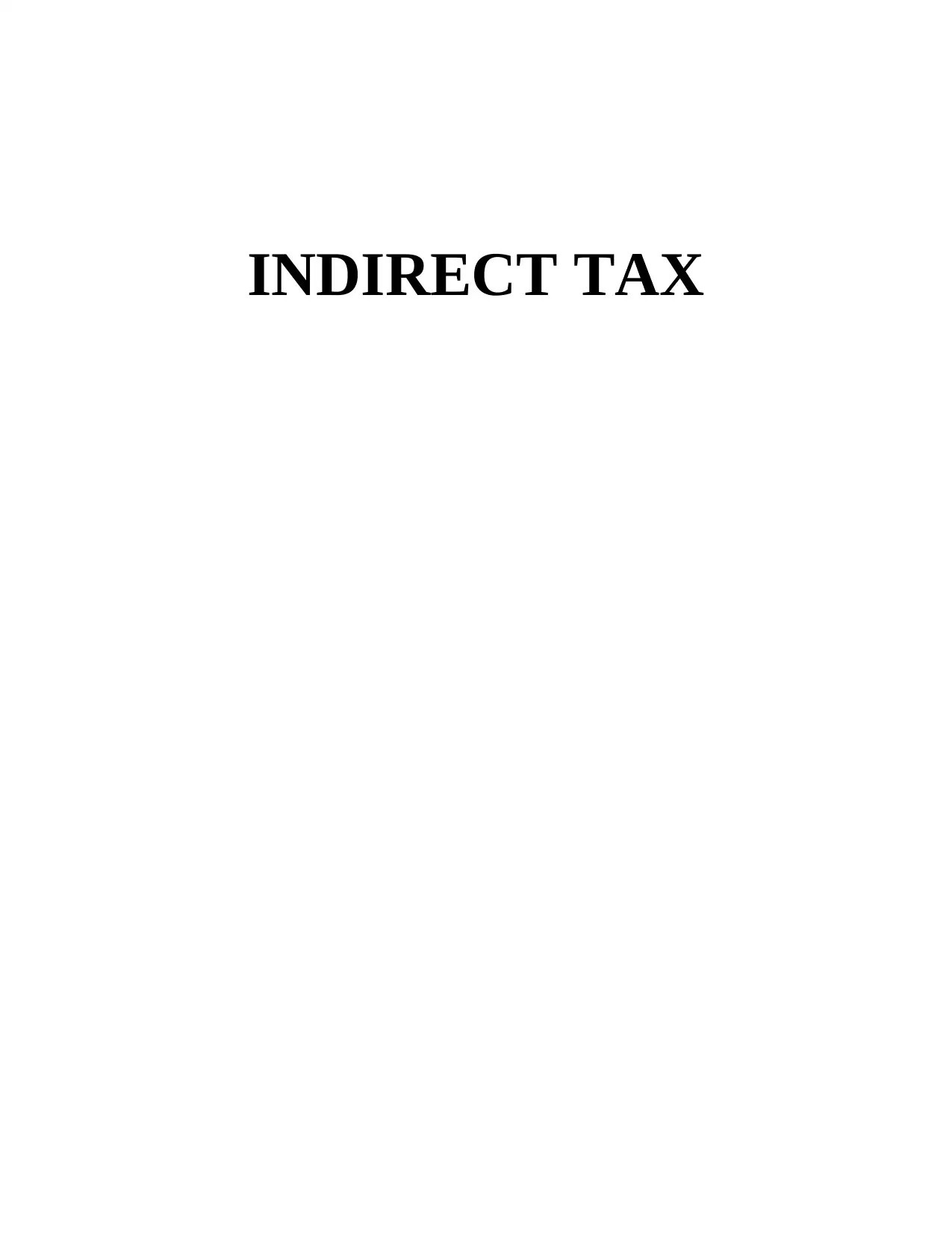
INDIRECT TAX
Secure Best Marks with AI Grader
Need help grading? Try our AI Grader for instant feedback on your assignments.

Table of Contents
INTRODUCTION...........................................................................................................................1
TASK 1............................................................................................................................................1
1.1 Source of information on VAT..............................................................................................1
1.2 Interaction of organisation with government agency.............................................................1
1.3 VAT registration requirements..............................................................................................2
1.4 Information required to considered for business documentation of VAT registered business
......................................................................................................................................................2
1.5 Requirements and the frequency of reporting for VAT schemes..........................................3
1.6 Up to date knowledge of changes to codes of practice, regulation or legislation..................3
TASK 2............................................................................................................................................4
2.1 relevant data for a specific period form the accounting system.............................................4
2.2 Calculation of input and outputs using the VAT classification.............................................5
2.3 Calculation of the VAT due to, or form the relevant tax authority........................................6
2.4 VAT return and associated payment with in the statutory time limits..................................6
TASK 3............................................................................................................................................7
3.1 The implications and penalties for an organisation resulting from failure to abide by VAT
regulations....................................................................................................................................7
3.2 Adjustments and declarations for any errors or omission identified in previous VAT
periods..........................................................................................................................................8
TASK 4............................................................................................................................................9
4.1 Inform the managers of the impact that the VAT payment may have organisations cash
flow..............................................................................................................................................9
4.2 VAT legislation which would have an effect on an organization's recording systems.......10
CONCLUSION .............................................................................................................................10
REFERENCES..............................................................................................................................11
INTRODUCTION...........................................................................................................................1
TASK 1............................................................................................................................................1
1.1 Source of information on VAT..............................................................................................1
1.2 Interaction of organisation with government agency.............................................................1
1.3 VAT registration requirements..............................................................................................2
1.4 Information required to considered for business documentation of VAT registered business
......................................................................................................................................................2
1.5 Requirements and the frequency of reporting for VAT schemes..........................................3
1.6 Up to date knowledge of changes to codes of practice, regulation or legislation..................3
TASK 2............................................................................................................................................4
2.1 relevant data for a specific period form the accounting system.............................................4
2.2 Calculation of input and outputs using the VAT classification.............................................5
2.3 Calculation of the VAT due to, or form the relevant tax authority........................................6
2.4 VAT return and associated payment with in the statutory time limits..................................6
TASK 3............................................................................................................................................7
3.1 The implications and penalties for an organisation resulting from failure to abide by VAT
regulations....................................................................................................................................7
3.2 Adjustments and declarations for any errors or omission identified in previous VAT
periods..........................................................................................................................................8
TASK 4............................................................................................................................................9
4.1 Inform the managers of the impact that the VAT payment may have organisations cash
flow..............................................................................................................................................9
4.2 VAT legislation which would have an effect on an organization's recording systems.......10
CONCLUSION .............................................................................................................................10
REFERENCES..............................................................................................................................11
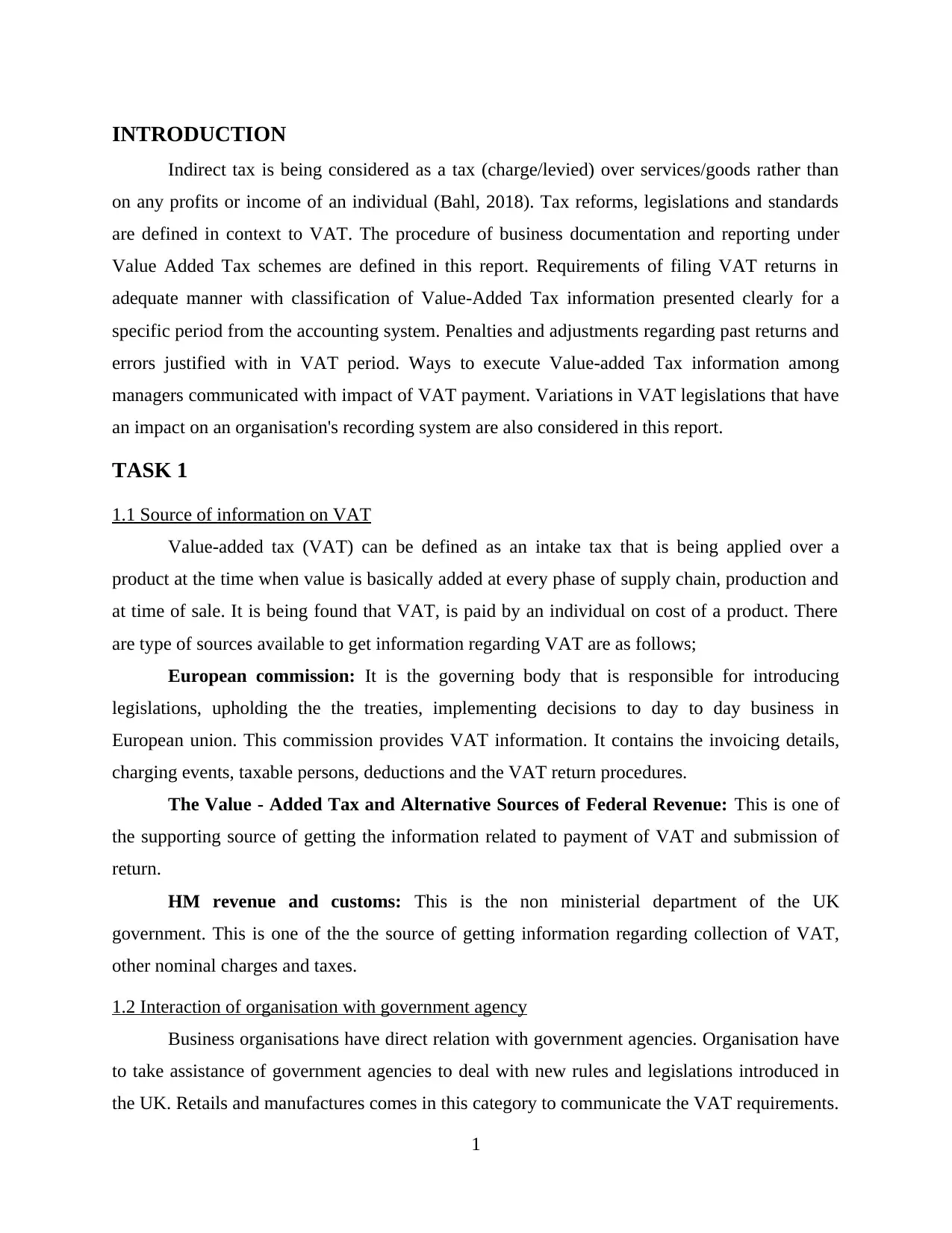
INTRODUCTION
Indirect tax is being considered as a tax (charge/levied) over services/goods rather than
on any profits or income of an individual (Bahl, 2018). Tax reforms, legislations and standards
are defined in context to VAT. The procedure of business documentation and reporting under
Value Added Tax schemes are defined in this report. Requirements of filing VAT returns in
adequate manner with classification of Value-Added Tax information presented clearly for a
specific period from the accounting system. Penalties and adjustments regarding past returns and
errors justified with in VAT period. Ways to execute Value-added Tax information among
managers communicated with impact of VAT payment. Variations in VAT legislations that have
an impact on an organisation's recording system are also considered in this report.
TASK 1
1.1 Source of information on VAT
Value-added tax (VAT) can be defined as an intake tax that is being applied over a
product at the time when value is basically added at every phase of supply chain, production and
at time of sale. It is being found that VAT, is paid by an individual on cost of a product. There
are type of sources available to get information regarding VAT are as follows;
European commission: It is the governing body that is responsible for introducing
legislations, upholding the the treaties, implementing decisions to day to day business in
European union. This commission provides VAT information. It contains the invoicing details,
charging events, taxable persons, deductions and the VAT return procedures.
The Value - Added Tax and Alternative Sources of Federal Revenue: This is one of
the supporting source of getting the information related to payment of VAT and submission of
return.
HM revenue and customs: This is the non ministerial department of the UK
government. This is one of the the source of getting information regarding collection of VAT,
other nominal charges and taxes.
1.2 Interaction of organisation with government agency
Business organisations have direct relation with government agencies. Organisation have
to take assistance of government agencies to deal with new rules and legislations introduced in
the UK. Retails and manufactures comes in this category to communicate the VAT requirements.
1
Indirect tax is being considered as a tax (charge/levied) over services/goods rather than
on any profits or income of an individual (Bahl, 2018). Tax reforms, legislations and standards
are defined in context to VAT. The procedure of business documentation and reporting under
Value Added Tax schemes are defined in this report. Requirements of filing VAT returns in
adequate manner with classification of Value-Added Tax information presented clearly for a
specific period from the accounting system. Penalties and adjustments regarding past returns and
errors justified with in VAT period. Ways to execute Value-added Tax information among
managers communicated with impact of VAT payment. Variations in VAT legislations that have
an impact on an organisation's recording system are also considered in this report.
TASK 1
1.1 Source of information on VAT
Value-added tax (VAT) can be defined as an intake tax that is being applied over a
product at the time when value is basically added at every phase of supply chain, production and
at time of sale. It is being found that VAT, is paid by an individual on cost of a product. There
are type of sources available to get information regarding VAT are as follows;
European commission: It is the governing body that is responsible for introducing
legislations, upholding the the treaties, implementing decisions to day to day business in
European union. This commission provides VAT information. It contains the invoicing details,
charging events, taxable persons, deductions and the VAT return procedures.
The Value - Added Tax and Alternative Sources of Federal Revenue: This is one of
the supporting source of getting the information related to payment of VAT and submission of
return.
HM revenue and customs: This is the non ministerial department of the UK
government. This is one of the the source of getting information regarding collection of VAT,
other nominal charges and taxes.
1.2 Interaction of organisation with government agency
Business organisations have direct relation with government agencies. Organisation have
to take assistance of government agencies to deal with new rules and legislations introduced in
the UK. Retails and manufactures comes in this category to communicate the VAT requirements.
1
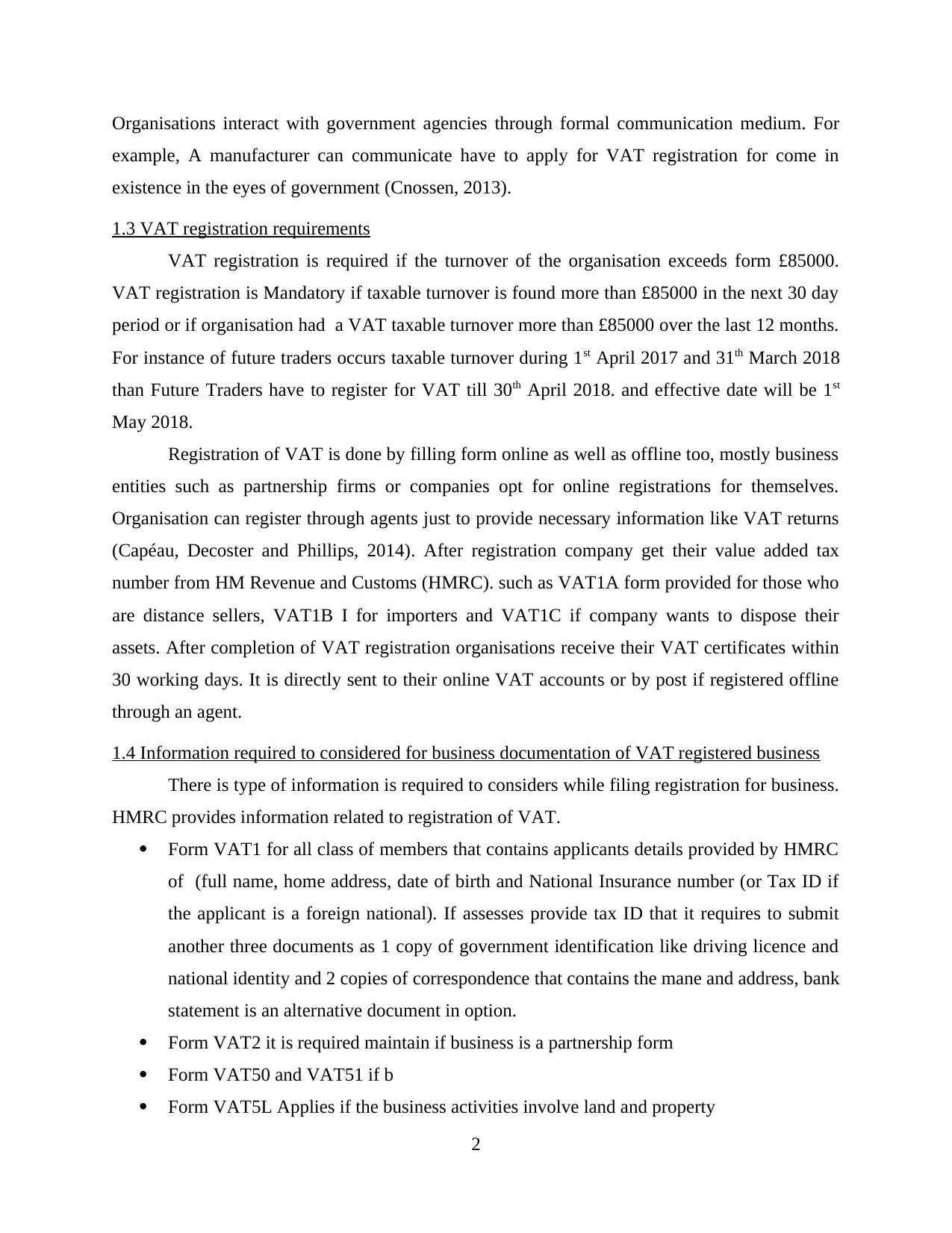
Organisations interact with government agencies through formal communication medium. For
example, A manufacturer can communicate have to apply for VAT registration for come in
existence in the eyes of government (Cnossen, 2013).
1.3 VAT registration requirements
VAT registration is required if the turnover of the organisation exceeds form £85000.
VAT registration is Mandatory if taxable turnover is found more than £85000 in the next 30 day
period or if organisation had a VAT taxable turnover more than £85000 over the last 12 months.
For instance of future traders occurs taxable turnover during 1st April 2017 and 31th March 2018
than Future Traders have to register for VAT till 30th April 2018. and effective date will be 1st
May 2018.
Registration of VAT is done by filling form online as well as offline too, mostly business
entities such as partnership firms or companies opt for online registrations for themselves.
Organisation can register through agents just to provide necessary information like VAT returns
(Capéau, Decoster and Phillips, 2014). After registration company get their value added tax
number from HM Revenue and Customs (HMRC). such as VAT1A form provided for those who
are distance sellers, VAT1B I for importers and VAT1C if company wants to dispose their
assets. After completion of VAT registration organisations receive their VAT certificates within
30 working days. It is directly sent to their online VAT accounts or by post if registered offline
through an agent.
1.4 Information required to considered for business documentation of VAT registered business
There is type of information is required to considers while filing registration for business.
HMRC provides information related to registration of VAT.
Form VAT1 for all class of members that contains applicants details provided by HMRC
of (full name, home address, date of birth and National Insurance number (or Tax ID if
the applicant is a foreign national). If assesses provide tax ID that it requires to submit
another three documents as 1 copy of government identification like driving licence and
national identity and 2 copies of correspondence that contains the mane and address, bank
statement is an alternative document in option.
Form VAT2 it is required maintain if business is a partnership form
Form VAT50 and VAT51 if b
Form VAT5L Applies if the business activities involve land and property
2
example, A manufacturer can communicate have to apply for VAT registration for come in
existence in the eyes of government (Cnossen, 2013).
1.3 VAT registration requirements
VAT registration is required if the turnover of the organisation exceeds form £85000.
VAT registration is Mandatory if taxable turnover is found more than £85000 in the next 30 day
period or if organisation had a VAT taxable turnover more than £85000 over the last 12 months.
For instance of future traders occurs taxable turnover during 1st April 2017 and 31th March 2018
than Future Traders have to register for VAT till 30th April 2018. and effective date will be 1st
May 2018.
Registration of VAT is done by filling form online as well as offline too, mostly business
entities such as partnership firms or companies opt for online registrations for themselves.
Organisation can register through agents just to provide necessary information like VAT returns
(Capéau, Decoster and Phillips, 2014). After registration company get their value added tax
number from HM Revenue and Customs (HMRC). such as VAT1A form provided for those who
are distance sellers, VAT1B I for importers and VAT1C if company wants to dispose their
assets. After completion of VAT registration organisations receive their VAT certificates within
30 working days. It is directly sent to their online VAT accounts or by post if registered offline
through an agent.
1.4 Information required to considered for business documentation of VAT registered business
There is type of information is required to considers while filing registration for business.
HMRC provides information related to registration of VAT.
Form VAT1 for all class of members that contains applicants details provided by HMRC
of (full name, home address, date of birth and National Insurance number (or Tax ID if
the applicant is a foreign national). If assesses provide tax ID that it requires to submit
another three documents as 1 copy of government identification like driving licence and
national identity and 2 copies of correspondence that contains the mane and address, bank
statement is an alternative document in option.
Form VAT2 it is required maintain if business is a partnership form
Form VAT50 and VAT51 if b
Form VAT5L Applies if the business activities involve land and property
2
Secure Best Marks with AI Grader
Need help grading? Try our AI Grader for instant feedback on your assignments.
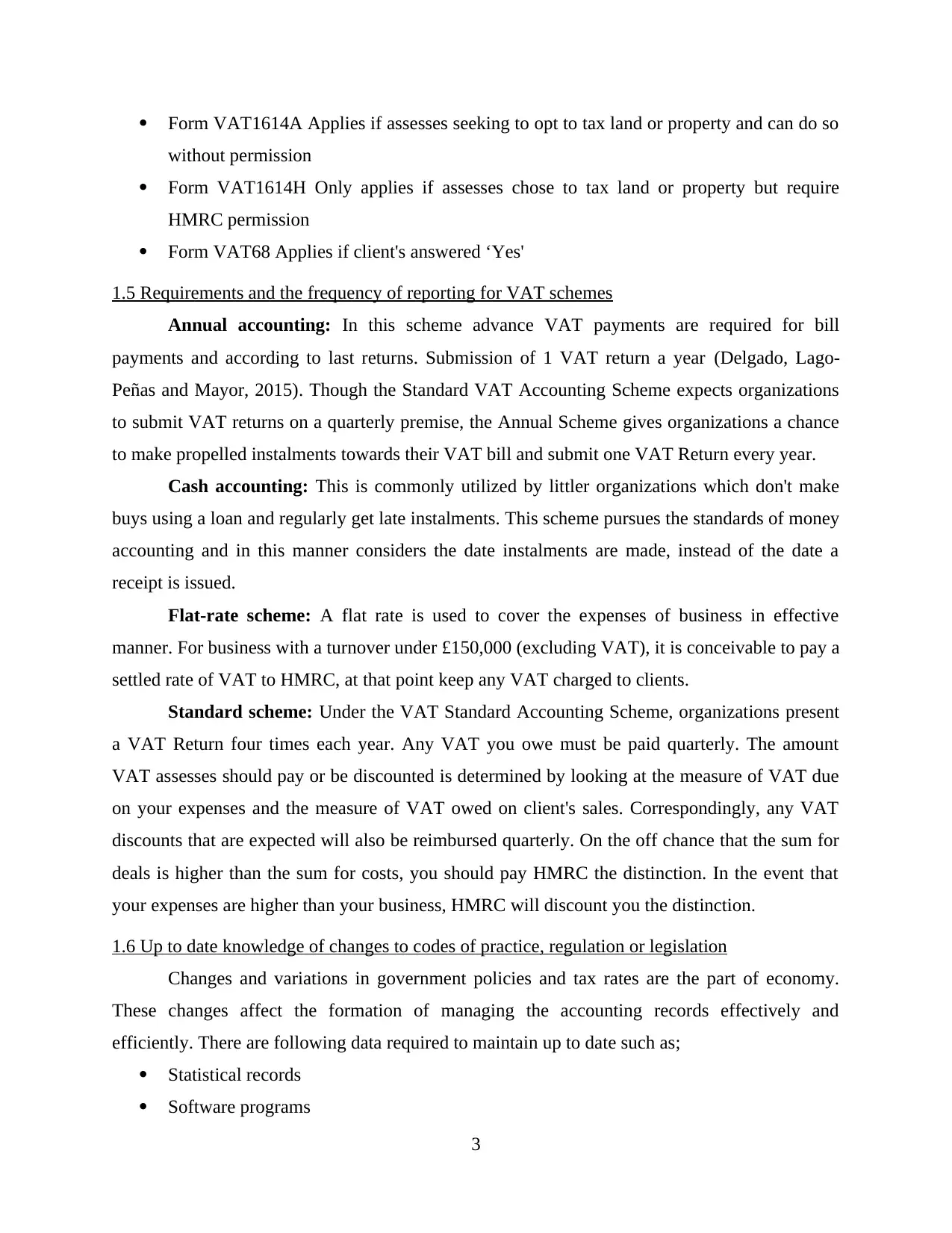
Form VAT1614A Applies if assesses seeking to opt to tax land or property and can do so
without permission
Form VAT1614H Only applies if assesses chose to tax land or property but require
HMRC permission
Form VAT68 Applies if client's answered ‘Yes'
1.5 Requirements and the frequency of reporting for VAT schemes
Annual accounting: In this scheme advance VAT payments are required for bill
payments and according to last returns. Submission of 1 VAT return a year (Delgado, Lago‐
Peñas and Mayor, 2015). Though the Standard VAT Accounting Scheme expects organizations
to submit VAT returns on a quarterly premise, the Annual Scheme gives organizations a chance
to make propelled instalments towards their VAT bill and submit one VAT Return every year.
Cash accounting: This is commonly utilized by littler organizations which don't make
buys using a loan and regularly get late instalments. This scheme pursues the standards of money
accounting and in this manner considers the date instalments are made, instead of the date a
receipt is issued.
Flat-rate scheme: A flat rate is used to cover the expenses of business in effective
manner. For business with a turnover under £150,000 (excluding VAT), it is conceivable to pay a
settled rate of VAT to HMRC, at that point keep any VAT charged to clients.
Standard scheme: Under the VAT Standard Accounting Scheme, organizations present
a VAT Return four times each year. Any VAT you owe must be paid quarterly. The amount
VAT assesses should pay or be discounted is determined by looking at the measure of VAT due
on your expenses and the measure of VAT owed on client's sales. Correspondingly, any VAT
discounts that are expected will also be reimbursed quarterly. On the off chance that the sum for
deals is higher than the sum for costs, you should pay HMRC the distinction. In the event that
your expenses are higher than your business, HMRC will discount you the distinction.
1.6 Up to date knowledge of changes to codes of practice, regulation or legislation
Changes and variations in government policies and tax rates are the part of economy.
These changes affect the formation of managing the accounting records effectively and
efficiently. There are following data required to maintain up to date such as;
Statistical records
Software programs
3
without permission
Form VAT1614H Only applies if assesses chose to tax land or property but require
HMRC permission
Form VAT68 Applies if client's answered ‘Yes'
1.5 Requirements and the frequency of reporting for VAT schemes
Annual accounting: In this scheme advance VAT payments are required for bill
payments and according to last returns. Submission of 1 VAT return a year (Delgado, Lago‐
Peñas and Mayor, 2015). Though the Standard VAT Accounting Scheme expects organizations
to submit VAT returns on a quarterly premise, the Annual Scheme gives organizations a chance
to make propelled instalments towards their VAT bill and submit one VAT Return every year.
Cash accounting: This is commonly utilized by littler organizations which don't make
buys using a loan and regularly get late instalments. This scheme pursues the standards of money
accounting and in this manner considers the date instalments are made, instead of the date a
receipt is issued.
Flat-rate scheme: A flat rate is used to cover the expenses of business in effective
manner. For business with a turnover under £150,000 (excluding VAT), it is conceivable to pay a
settled rate of VAT to HMRC, at that point keep any VAT charged to clients.
Standard scheme: Under the VAT Standard Accounting Scheme, organizations present
a VAT Return four times each year. Any VAT you owe must be paid quarterly. The amount
VAT assesses should pay or be discounted is determined by looking at the measure of VAT due
on your expenses and the measure of VAT owed on client's sales. Correspondingly, any VAT
discounts that are expected will also be reimbursed quarterly. On the off chance that the sum for
deals is higher than the sum for costs, you should pay HMRC the distinction. In the event that
your expenses are higher than your business, HMRC will discount you the distinction.
1.6 Up to date knowledge of changes to codes of practice, regulation or legislation
Changes and variations in government policies and tax rates are the part of economy.
These changes affect the formation of managing the accounting records effectively and
efficiently. There are following data required to maintain up to date such as;
Statistical records
Software programs
3
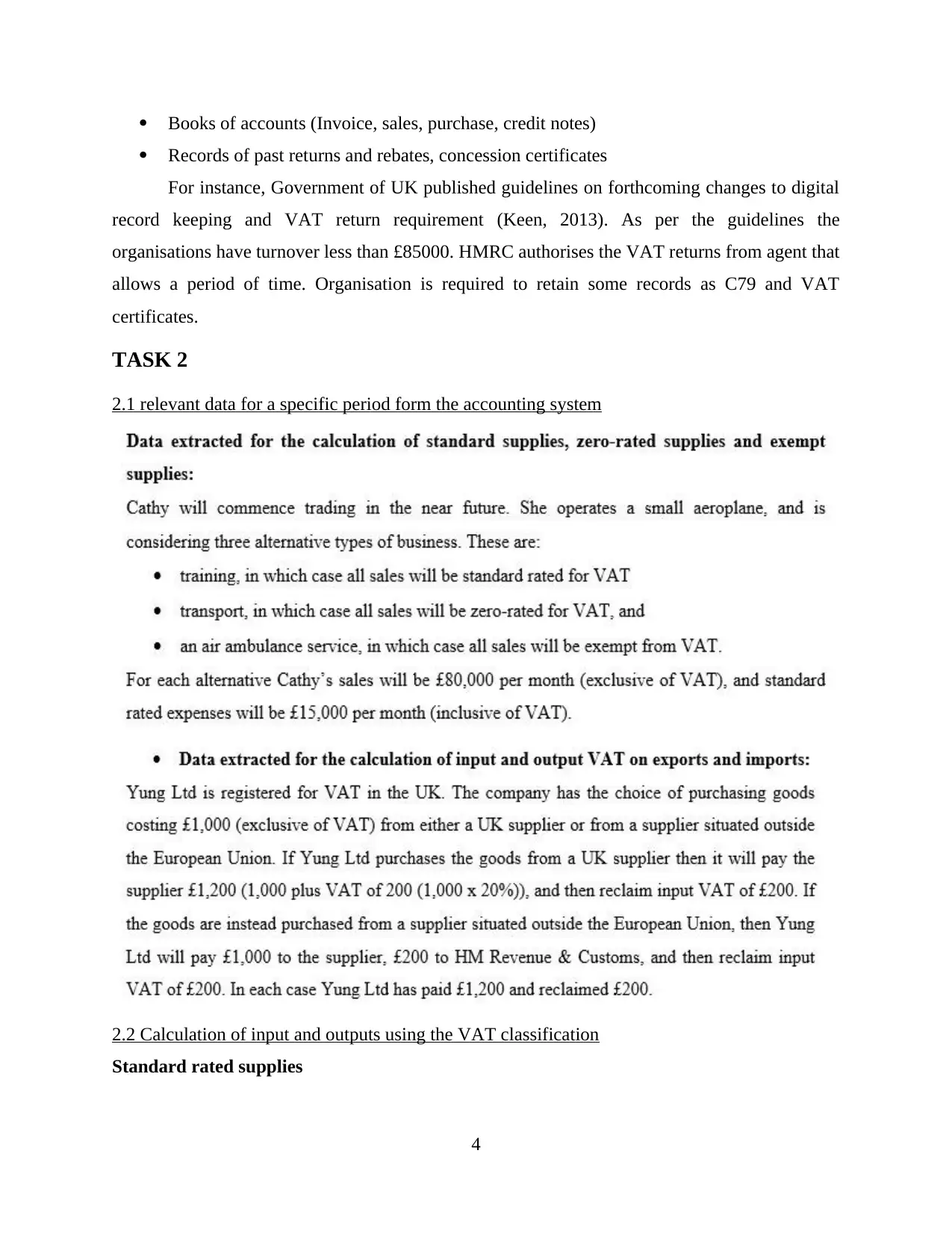
Books of accounts (Invoice, sales, purchase, credit notes)
Records of past returns and rebates, concession certificates
For instance, Government of UK published guidelines on forthcoming changes to digital
record keeping and VAT return requirement (Keen, 2013). As per the guidelines the
organisations have turnover less than £85000. HMRC authorises the VAT returns from agent that
allows a period of time. Organisation is required to retain some records as C79 and VAT
certificates.
TASK 2
2.1 relevant data for a specific period form the accounting system
2.2 Calculation of input and outputs using the VAT classification
Standard rated supplies
4
Records of past returns and rebates, concession certificates
For instance, Government of UK published guidelines on forthcoming changes to digital
record keeping and VAT return requirement (Keen, 2013). As per the guidelines the
organisations have turnover less than £85000. HMRC authorises the VAT returns from agent that
allows a period of time. Organisation is required to retain some records as C79 and VAT
certificates.
TASK 2
2.1 relevant data for a specific period form the accounting system
2.2 Calculation of input and outputs using the VAT classification
Standard rated supplies
4
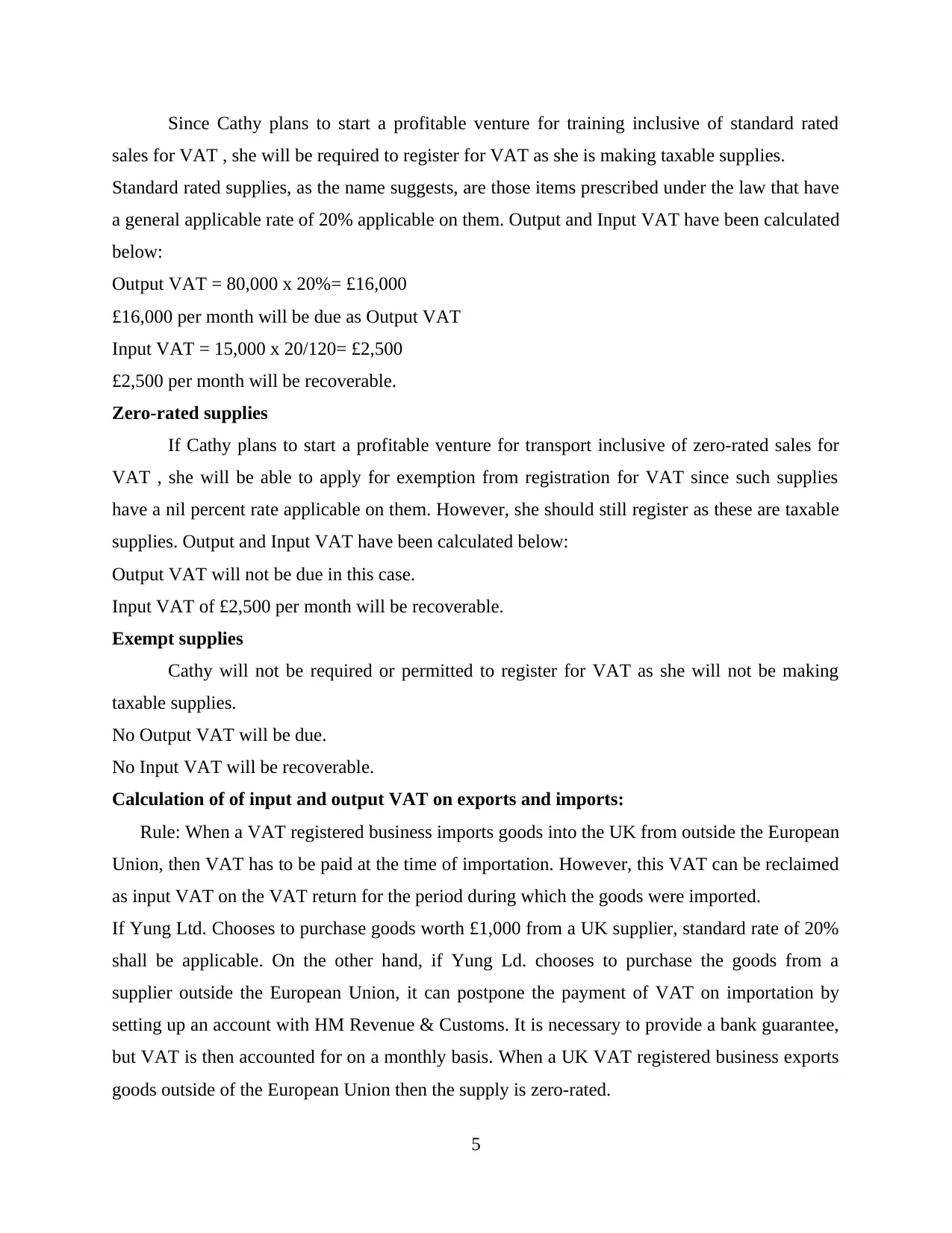
Since Cathy plans to start a profitable venture for training inclusive of standard rated
sales for VAT , she will be required to register for VAT as she is making taxable supplies.
Standard rated supplies, as the name suggests, are those items prescribed under the law that have
a general applicable rate of 20% applicable on them. Output and Input VAT have been calculated
below:
Output VAT = 80,000 x 20%= £16,000
£16,000 per month will be due as Output VAT
Input VAT = 15,000 x 20/120= £2,500
£2,500 per month will be recoverable.
Zero-rated supplies
If Cathy plans to start a profitable venture for transport inclusive of zero-rated sales for
VAT , she will be able to apply for exemption from registration for VAT since such supplies
have a nil percent rate applicable on them. However, she should still register as these are taxable
supplies. Output and Input VAT have been calculated below:
Output VAT will not be due in this case.
Input VAT of £2,500 per month will be recoverable.
Exempt supplies
Cathy will not be required or permitted to register for VAT as she will not be making
taxable supplies.
No Output VAT will be due.
No Input VAT will be recoverable.
Calculation of of input and output VAT on exports and imports:
Rule: When a VAT registered business imports goods into the UK from outside the European
Union, then VAT has to be paid at the time of importation. However, this VAT can be reclaimed
as input VAT on the VAT return for the period during which the goods were imported.
If Yung Ltd. Chooses to purchase goods worth £1,000 from a UK supplier, standard rate of 20%
shall be applicable. On the other hand, if Yung Ld. chooses to purchase the goods from a
supplier outside the European Union, it can postpone the payment of VAT on importation by
setting up an account with HM Revenue & Customs. It is necessary to provide a bank guarantee,
but VAT is then accounted for on a monthly basis. When a UK VAT registered business exports
goods outside of the European Union then the supply is zero-rated.
5
sales for VAT , she will be required to register for VAT as she is making taxable supplies.
Standard rated supplies, as the name suggests, are those items prescribed under the law that have
a general applicable rate of 20% applicable on them. Output and Input VAT have been calculated
below:
Output VAT = 80,000 x 20%= £16,000
£16,000 per month will be due as Output VAT
Input VAT = 15,000 x 20/120= £2,500
£2,500 per month will be recoverable.
Zero-rated supplies
If Cathy plans to start a profitable venture for transport inclusive of zero-rated sales for
VAT , she will be able to apply for exemption from registration for VAT since such supplies
have a nil percent rate applicable on them. However, she should still register as these are taxable
supplies. Output and Input VAT have been calculated below:
Output VAT will not be due in this case.
Input VAT of £2,500 per month will be recoverable.
Exempt supplies
Cathy will not be required or permitted to register for VAT as she will not be making
taxable supplies.
No Output VAT will be due.
No Input VAT will be recoverable.
Calculation of of input and output VAT on exports and imports:
Rule: When a VAT registered business imports goods into the UK from outside the European
Union, then VAT has to be paid at the time of importation. However, this VAT can be reclaimed
as input VAT on the VAT return for the period during which the goods were imported.
If Yung Ltd. Chooses to purchase goods worth £1,000 from a UK supplier, standard rate of 20%
shall be applicable. On the other hand, if Yung Ld. chooses to purchase the goods from a
supplier outside the European Union, it can postpone the payment of VAT on importation by
setting up an account with HM Revenue & Customs. It is necessary to provide a bank guarantee,
but VAT is then accounted for on a monthly basis. When a UK VAT registered business exports
goods outside of the European Union then the supply is zero-rated.
5
Paraphrase This Document
Need a fresh take? Get an instant paraphrase of this document with our AI Paraphraser
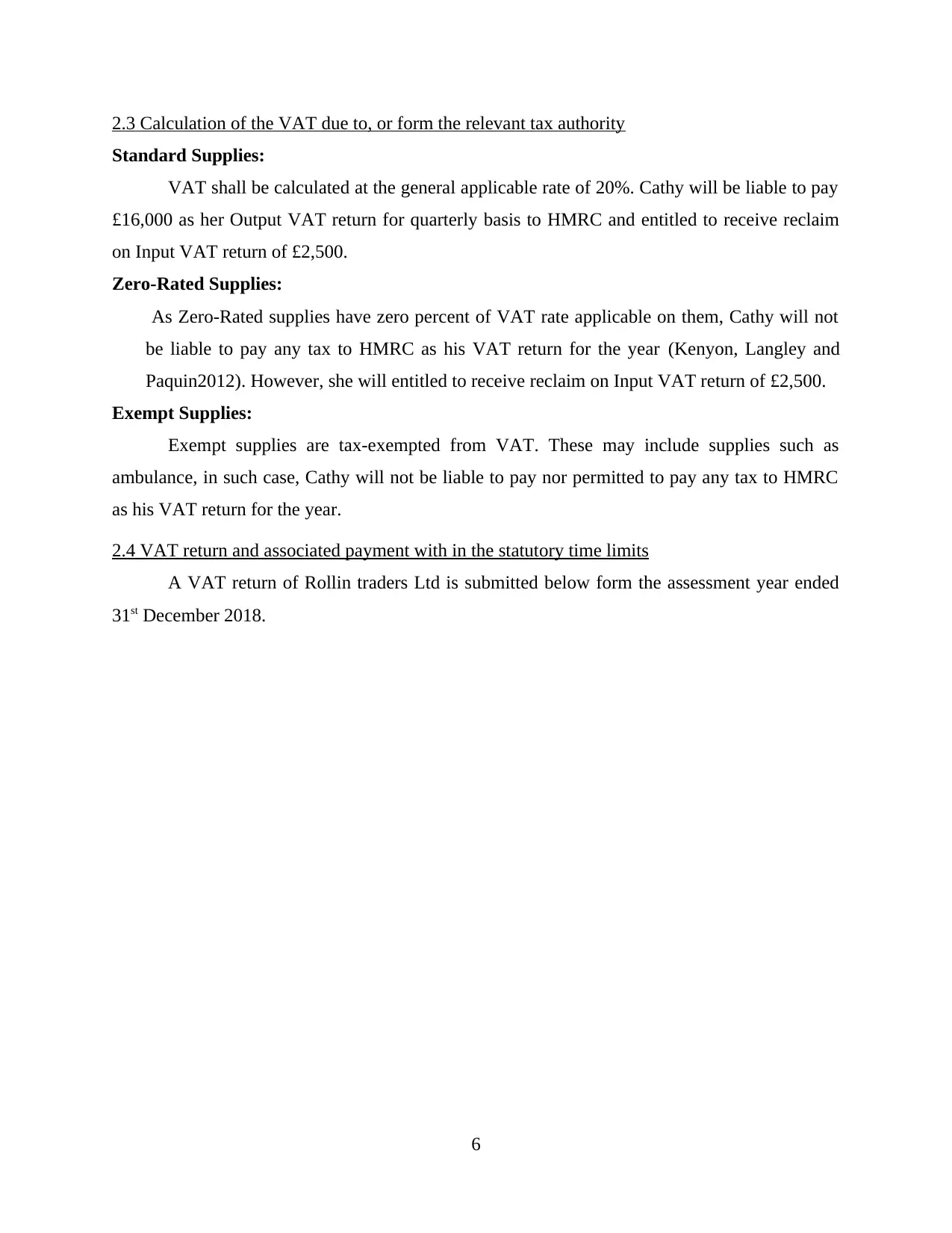
2.3 Calculation of the VAT due to, or form the relevant tax authority
Standard Supplies:
VAT shall be calculated at the general applicable rate of 20%. Cathy will be liable to pay
£16,000 as her Output VAT return for quarterly basis to HMRC and entitled to receive reclaim
on Input VAT return of £2,500.
Zero-Rated Supplies:
As Zero-Rated supplies have zero percent of VAT rate applicable on them, Cathy will not
be liable to pay any tax to HMRC as his VAT return for the year (Kenyon, Langley and
Paquin2012). However, she will entitled to receive reclaim on Input VAT return of £2,500.
Exempt Supplies:
Exempt supplies are tax-exempted from VAT. These may include supplies such as
ambulance, in such case, Cathy will not be liable to pay nor permitted to pay any tax to HMRC
as his VAT return for the year.
2.4 VAT return and associated payment with in the statutory time limits
A VAT return of Rollin traders Ltd is submitted below form the assessment year ended
31st December 2018.
6
Standard Supplies:
VAT shall be calculated at the general applicable rate of 20%. Cathy will be liable to pay
£16,000 as her Output VAT return for quarterly basis to HMRC and entitled to receive reclaim
on Input VAT return of £2,500.
Zero-Rated Supplies:
As Zero-Rated supplies have zero percent of VAT rate applicable on them, Cathy will not
be liable to pay any tax to HMRC as his VAT return for the year (Kenyon, Langley and
Paquin2012). However, she will entitled to receive reclaim on Input VAT return of £2,500.
Exempt Supplies:
Exempt supplies are tax-exempted from VAT. These may include supplies such as
ambulance, in such case, Cathy will not be liable to pay nor permitted to pay any tax to HMRC
as his VAT return for the year.
2.4 VAT return and associated payment with in the statutory time limits
A VAT return of Rollin traders Ltd is submitted below form the assessment year ended
31st December 2018.
6
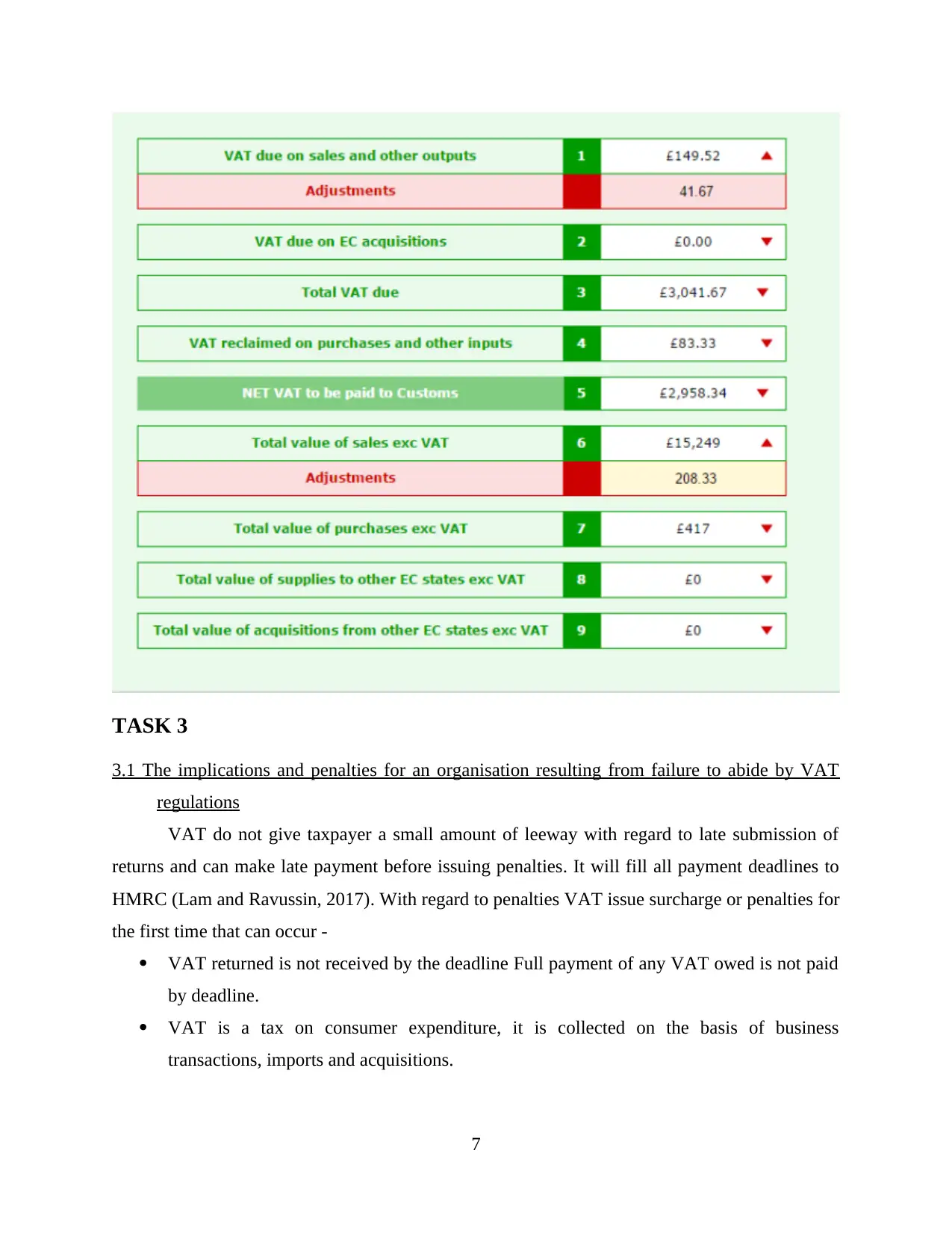
TASK 3
3.1 The implications and penalties for an organisation resulting from failure to abide by VAT
regulations
VAT do not give taxpayer a small amount of leeway with regard to late submission of
returns and can make late payment before issuing penalties. It will fill all payment deadlines to
HMRC (Lam and Ravussin, 2017). With regard to penalties VAT issue surcharge or penalties for
the first time that can occur -
VAT returned is not received by the deadline Full payment of any VAT owed is not paid
by deadline.
VAT is a tax on consumer expenditure, it is collected on the basis of business
transactions, imports and acquisitions.
7
3.1 The implications and penalties for an organisation resulting from failure to abide by VAT
regulations
VAT do not give taxpayer a small amount of leeway with regard to late submission of
returns and can make late payment before issuing penalties. It will fill all payment deadlines to
HMRC (Lam and Ravussin, 2017). With regard to penalties VAT issue surcharge or penalties for
the first time that can occur -
VAT returned is not received by the deadline Full payment of any VAT owed is not paid
by deadline.
VAT is a tax on consumer expenditure, it is collected on the basis of business
transactions, imports and acquisitions.
7
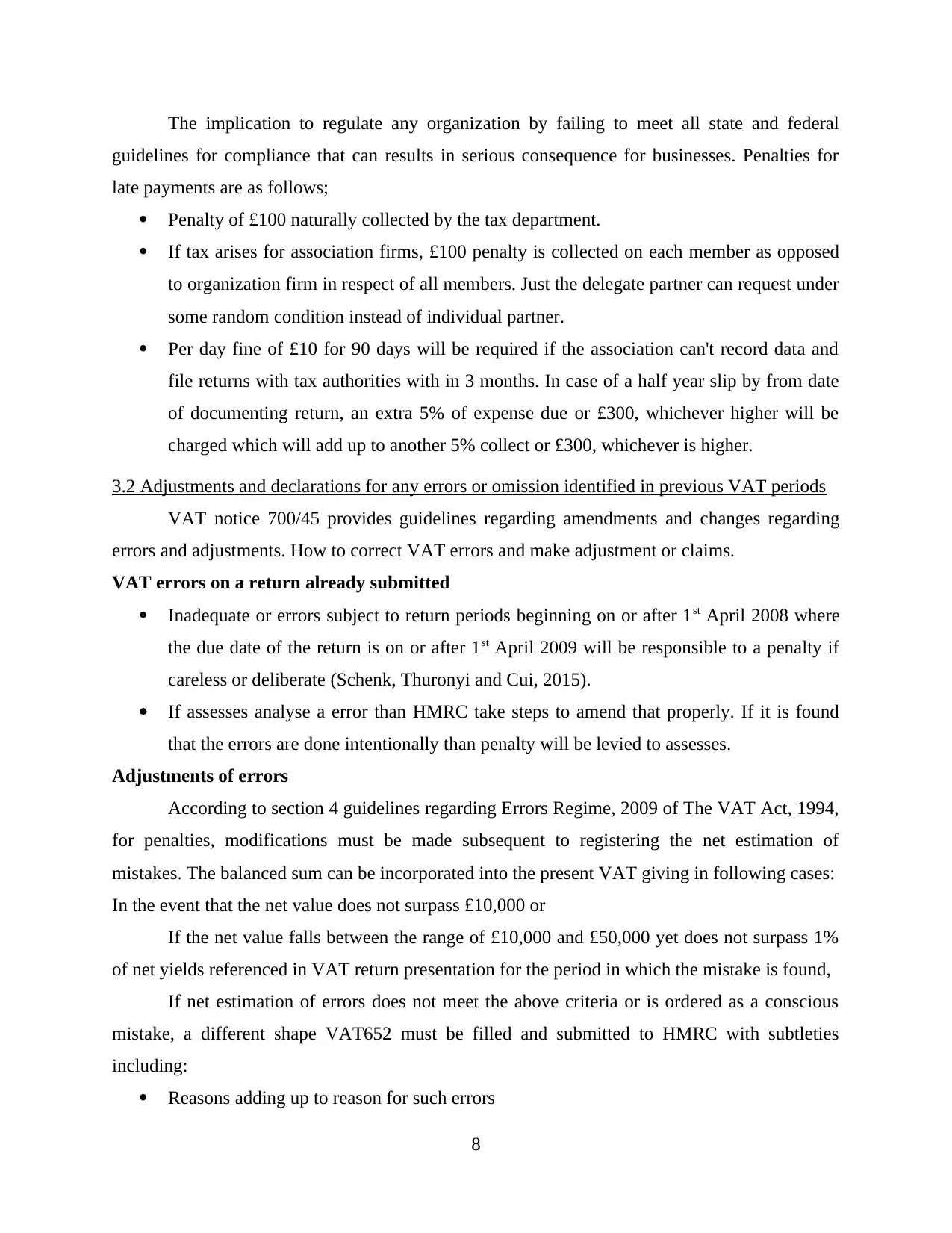
The implication to regulate any organization by failing to meet all state and federal
guidelines for compliance that can results in serious consequence for businesses. Penalties for
late payments are as follows;
Penalty of £100 naturally collected by the tax department.
If tax arises for association firms, £100 penalty is collected on each member as opposed
to organization firm in respect of all members. Just the delegate partner can request under
some random condition instead of individual partner.
Per day fine of £10 for 90 days will be required if the association can't record data and
file returns with tax authorities with in 3 months. In case of a half year slip by from date
of documenting return, an extra 5% of expense due or £300, whichever higher will be
charged which will add up to another 5% collect or £300, whichever is higher.
3.2 Adjustments and declarations for any errors or omission identified in previous VAT periods
VAT notice 700/45 provides guidelines regarding amendments and changes regarding
errors and adjustments. How to correct VAT errors and make adjustment or claims.
VAT errors on a return already submitted
Inadequate or errors subject to return periods beginning on or after 1st April 2008 where
the due date of the return is on or after 1st April 2009 will be responsible to a penalty if
careless or deliberate (Schenk, Thuronyi and Cui, 2015).
If assesses analyse a error than HMRC take steps to amend that properly. If it is found
that the errors are done intentionally than penalty will be levied to assesses.
Adjustments of errors
According to section 4 guidelines regarding Errors Regime, 2009 of The VAT Act, 1994,
for penalties, modifications must be made subsequent to registering the net estimation of
mistakes. The balanced sum can be incorporated into the present VAT giving in following cases:
In the event that the net value does not surpass £10,000 or
If the net value falls between the range of £10,000 and £50,000 yet does not surpass 1%
of net yields referenced in VAT return presentation for the period in which the mistake is found,
If net estimation of errors does not meet the above criteria or is ordered as a conscious
mistake, a different shape VAT652 must be filled and submitted to HMRC with subtleties
including:
Reasons adding up to reason for such errors
8
guidelines for compliance that can results in serious consequence for businesses. Penalties for
late payments are as follows;
Penalty of £100 naturally collected by the tax department.
If tax arises for association firms, £100 penalty is collected on each member as opposed
to organization firm in respect of all members. Just the delegate partner can request under
some random condition instead of individual partner.
Per day fine of £10 for 90 days will be required if the association can't record data and
file returns with tax authorities with in 3 months. In case of a half year slip by from date
of documenting return, an extra 5% of expense due or £300, whichever higher will be
charged which will add up to another 5% collect or £300, whichever is higher.
3.2 Adjustments and declarations for any errors or omission identified in previous VAT periods
VAT notice 700/45 provides guidelines regarding amendments and changes regarding
errors and adjustments. How to correct VAT errors and make adjustment or claims.
VAT errors on a return already submitted
Inadequate or errors subject to return periods beginning on or after 1st April 2008 where
the due date of the return is on or after 1st April 2009 will be responsible to a penalty if
careless or deliberate (Schenk, Thuronyi and Cui, 2015).
If assesses analyse a error than HMRC take steps to amend that properly. If it is found
that the errors are done intentionally than penalty will be levied to assesses.
Adjustments of errors
According to section 4 guidelines regarding Errors Regime, 2009 of The VAT Act, 1994,
for penalties, modifications must be made subsequent to registering the net estimation of
mistakes. The balanced sum can be incorporated into the present VAT giving in following cases:
In the event that the net value does not surpass £10,000 or
If the net value falls between the range of £10,000 and £50,000 yet does not surpass 1%
of net yields referenced in VAT return presentation for the period in which the mistake is found,
If net estimation of errors does not meet the above criteria or is ordered as a conscious
mistake, a different shape VAT652 must be filled and submitted to HMRC with subtleties
including:
Reasons adding up to reason for such errors
8
Secure Best Marks with AI Grader
Need help grading? Try our AI Grader for instant feedback on your assignments.
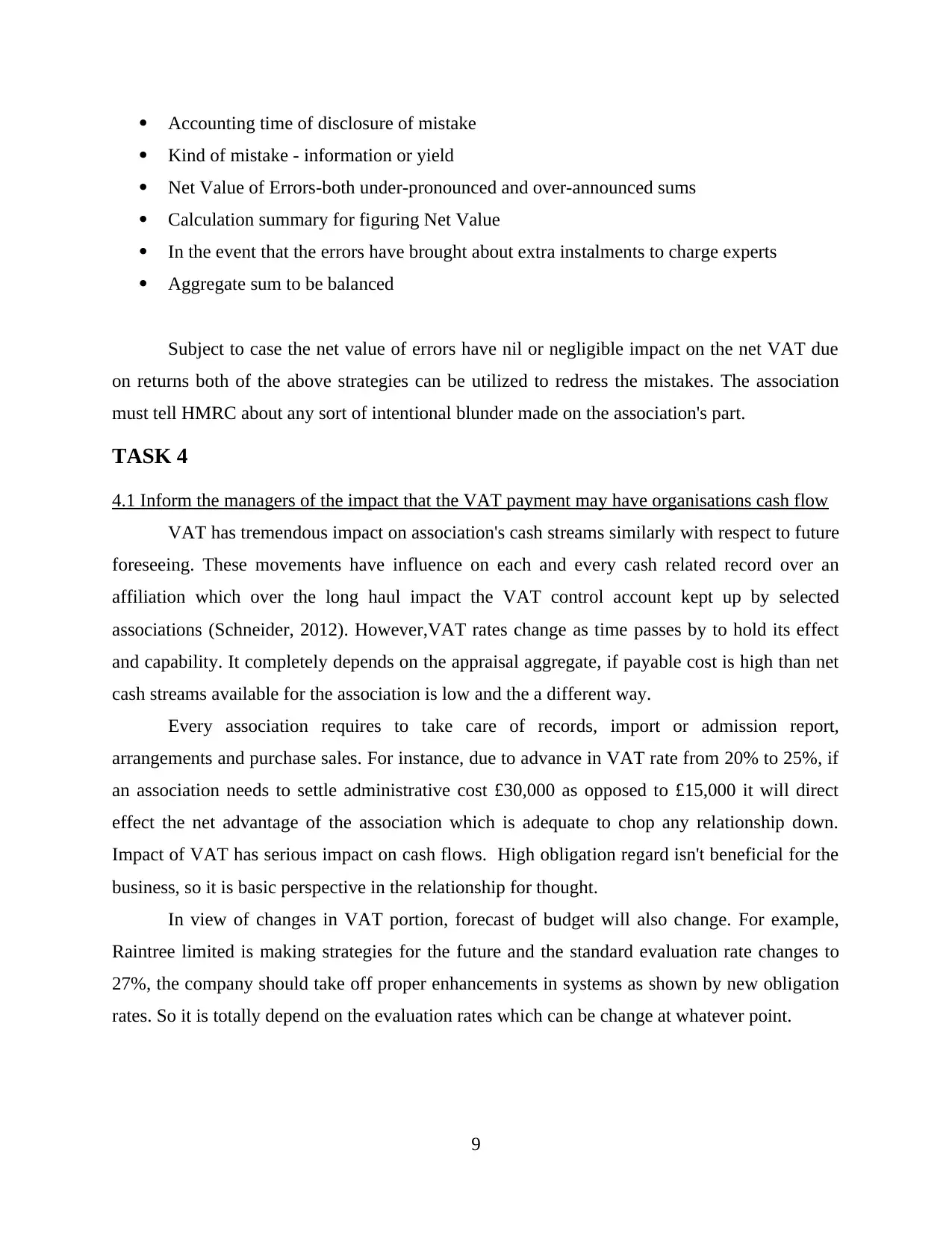
Accounting time of disclosure of mistake
Kind of mistake - information or yield
Net Value of Errors-both under-pronounced and over-announced sums
Calculation summary for figuring Net Value
In the event that the errors have brought about extra instalments to charge experts
Aggregate sum to be balanced
Subject to case the net value of errors have nil or negligible impact on the net VAT due
on returns both of the above strategies can be utilized to redress the mistakes. The association
must tell HMRC about any sort of intentional blunder made on the association's part.
TASK 4
4.1 Inform the managers of the impact that the VAT payment may have organisations cash flow
VAT has tremendous impact on association's cash streams similarly with respect to future
foreseeing. These movements have influence on each and every cash related record over an
affiliation which over the long haul impact the VAT control account kept up by selected
associations (Schneider, 2012). However,VAT rates change as time passes by to hold its effect
and capability. It completely depends on the appraisal aggregate, if payable cost is high than net
cash streams available for the association is low and the a different way.
Every association requires to take care of records, import or admission report,
arrangements and purchase sales. For instance, due to advance in VAT rate from 20% to 25%, if
an association needs to settle administrative cost £30,000 as opposed to £15,000 it will direct
effect the net advantage of the association which is adequate to chop any relationship down.
Impact of VAT has serious impact on cash flows. High obligation regard isn't beneficial for the
business, so it is basic perspective in the relationship for thought.
In view of changes in VAT portion, forecast of budget will also change. For example,
Raintree limited is making strategies for the future and the standard evaluation rate changes to
27%, the company should take off proper enhancements in systems as shown by new obligation
rates. So it is totally depend on the evaluation rates which can be change at whatever point.
9
Kind of mistake - information or yield
Net Value of Errors-both under-pronounced and over-announced sums
Calculation summary for figuring Net Value
In the event that the errors have brought about extra instalments to charge experts
Aggregate sum to be balanced
Subject to case the net value of errors have nil or negligible impact on the net VAT due
on returns both of the above strategies can be utilized to redress the mistakes. The association
must tell HMRC about any sort of intentional blunder made on the association's part.
TASK 4
4.1 Inform the managers of the impact that the VAT payment may have organisations cash flow
VAT has tremendous impact on association's cash streams similarly with respect to future
foreseeing. These movements have influence on each and every cash related record over an
affiliation which over the long haul impact the VAT control account kept up by selected
associations (Schneider, 2012). However,VAT rates change as time passes by to hold its effect
and capability. It completely depends on the appraisal aggregate, if payable cost is high than net
cash streams available for the association is low and the a different way.
Every association requires to take care of records, import or admission report,
arrangements and purchase sales. For instance, due to advance in VAT rate from 20% to 25%, if
an association needs to settle administrative cost £30,000 as opposed to £15,000 it will direct
effect the net advantage of the association which is adequate to chop any relationship down.
Impact of VAT has serious impact on cash flows. High obligation regard isn't beneficial for the
business, so it is basic perspective in the relationship for thought.
In view of changes in VAT portion, forecast of budget will also change. For example,
Raintree limited is making strategies for the future and the standard evaluation rate changes to
27%, the company should take off proper enhancements in systems as shown by new obligation
rates. So it is totally depend on the evaluation rates which can be change at whatever point.
9
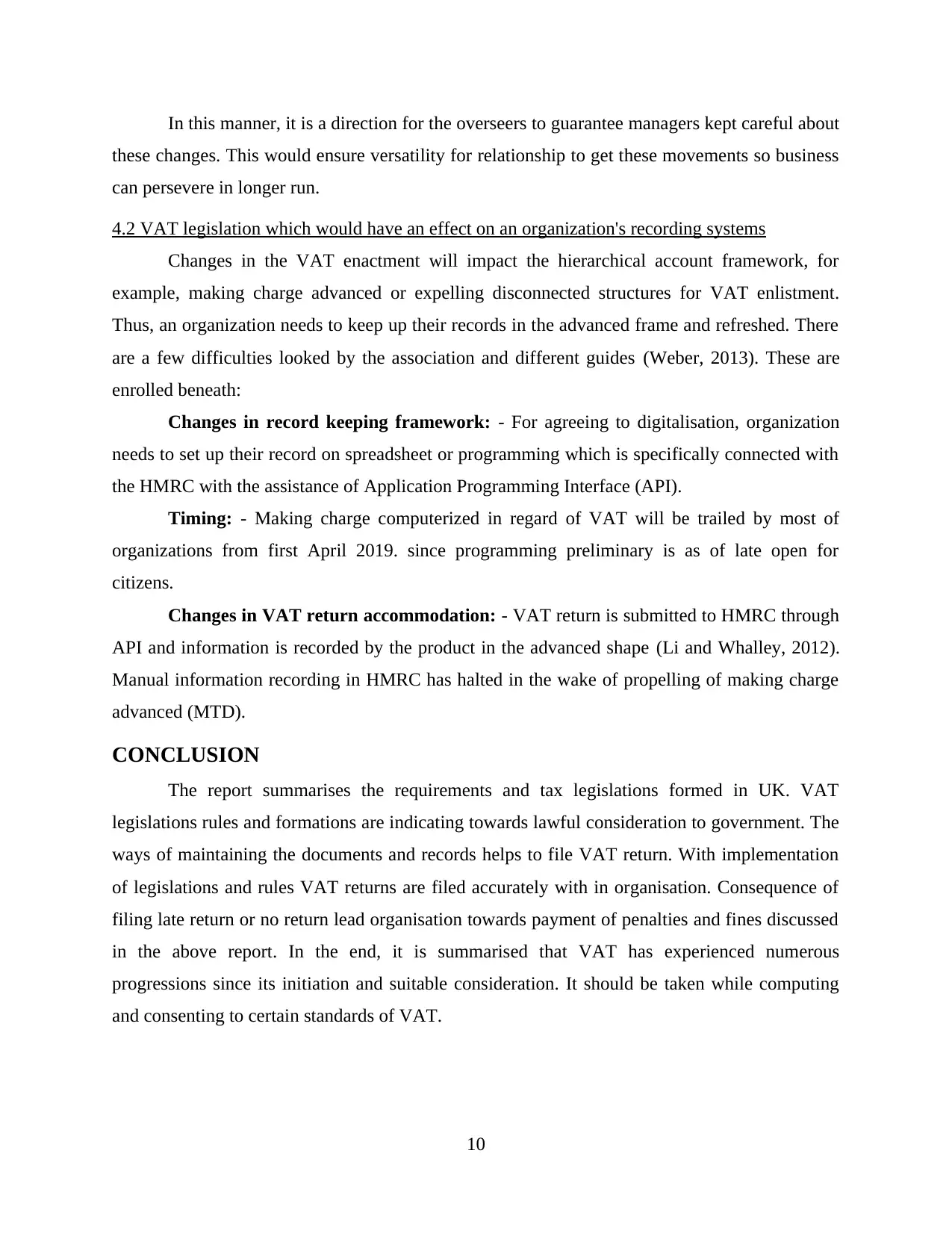
In this manner, it is a direction for the overseers to guarantee managers kept careful about
these changes. This would ensure versatility for relationship to get these movements so business
can persevere in longer run.
4.2 VAT legislation which would have an effect on an organization's recording systems
Changes in the VAT enactment will impact the hierarchical account framework, for
example, making charge advanced or expelling disconnected structures for VAT enlistment.
Thus, an organization needs to keep up their records in the advanced frame and refreshed. There
are a few difficulties looked by the association and different guides (Weber, 2013). These are
enrolled beneath:
Changes in record keeping framework: - For agreeing to digitalisation, organization
needs to set up their record on spreadsheet or programming which is specifically connected with
the HMRC with the assistance of Application Programming Interface (API).
Timing: - Making charge computerized in regard of VAT will be trailed by most of
organizations from first April 2019. since programming preliminary is as of late open for
citizens.
Changes in VAT return accommodation: - VAT return is submitted to HMRC through
API and information is recorded by the product in the advanced shape (Li and Whalley, 2012).
Manual information recording in HMRC has halted in the wake of propelling of making charge
advanced (MTD).
CONCLUSION
The report summarises the requirements and tax legislations formed in UK. VAT
legislations rules and formations are indicating towards lawful consideration to government. The
ways of maintaining the documents and records helps to file VAT return. With implementation
of legislations and rules VAT returns are filed accurately with in organisation. Consequence of
filing late return or no return lead organisation towards payment of penalties and fines discussed
in the above report. In the end, it is summarised that VAT has experienced numerous
progressions since its initiation and suitable consideration. It should be taken while computing
and consenting to certain standards of VAT.
10
these changes. This would ensure versatility for relationship to get these movements so business
can persevere in longer run.
4.2 VAT legislation which would have an effect on an organization's recording systems
Changes in the VAT enactment will impact the hierarchical account framework, for
example, making charge advanced or expelling disconnected structures for VAT enlistment.
Thus, an organization needs to keep up their records in the advanced frame and refreshed. There
are a few difficulties looked by the association and different guides (Weber, 2013). These are
enrolled beneath:
Changes in record keeping framework: - For agreeing to digitalisation, organization
needs to set up their record on spreadsheet or programming which is specifically connected with
the HMRC with the assistance of Application Programming Interface (API).
Timing: - Making charge computerized in regard of VAT will be trailed by most of
organizations from first April 2019. since programming preliminary is as of late open for
citizens.
Changes in VAT return accommodation: - VAT return is submitted to HMRC through
API and information is recorded by the product in the advanced shape (Li and Whalley, 2012).
Manual information recording in HMRC has halted in the wake of propelling of making charge
advanced (MTD).
CONCLUSION
The report summarises the requirements and tax legislations formed in UK. VAT
legislations rules and formations are indicating towards lawful consideration to government. The
ways of maintaining the documents and records helps to file VAT return. With implementation
of legislations and rules VAT returns are filed accurately with in organisation. Consequence of
filing late return or no return lead organisation towards payment of penalties and fines discussed
in the above report. In the end, it is summarised that VAT has experienced numerous
progressions since its initiation and suitable consideration. It should be taken while computing
and consenting to certain standards of VAT.
10

REFERENCES
Books and Journals:
Albayrak, Ö., 2017. Redistributive Effects of Indirect Taxes in Turkey 2003. Ankara Üniversitesi
Sosyal Bilimler Dergisi. 2(1).
Bahl, R., 2018. The Guatemalan tax reform. Routledge.
Delgado, F. J., Lago‐Peñas, S. and Mayor, M., 2015. On the determinants of local tax rates: new
evidence from Spain. Contemporary Economic Policy. 33(2). pp.351-368.
Keen, M. M., 2013. Targeting, cascading, and indirect tax desig (No. 13-57). International
Monetary Fund.
Kenyon, D. A., Langley, A. H. and Paquin, B. P., 2012. Rethinking property tax incentives for
business. Cambridge, MA: Lincoln Institute of Land Policy.
Lam, Y. Y. and Ravussin, E., 2017. Indirect calorimetry: an indispensable tool to understand and
predict obesity. European journal of clinical nutrition. 71(3). p.318.
Li, C. and Whalley, J., 2012. Indirect tax initiatives and global rebalancing (No. w17919).
National Bureau of Economic Research.
Littlewood, J., Murphy, R. J. and Wang, L., 2013. Importance of policy support and feedstock
prices on economic feasibility of bioethanol production from wheat straw in the
UK. Renewable and Sustainable Energy Reviews. 17. pp.291-300.
Schenk, A., Thuronyi, V. and Cui, W., 2015. Value added tax. Cambridge University Press.
Schneider, A., 2012. State-building and tax regimes in Central America. Cambridge University
Press.
Weber, D., 2013. Abuse of Law in European Tax Law: An Overview and Some Recent Trends
in the Direct and Indirect Tax Case Law of the ECJ-part 1. European Taxation. 53(6).
pp.251-264.
Williams, C. and Martinez, A., 2014. Do small business start-ups test-trade in the informal
economy? Evidence from a UK survey. International Journal of Entrepreneurship and
Small Business. 22(1).
11
Books and Journals:
Albayrak, Ö., 2017. Redistributive Effects of Indirect Taxes in Turkey 2003. Ankara Üniversitesi
Sosyal Bilimler Dergisi. 2(1).
Bahl, R., 2018. The Guatemalan tax reform. Routledge.
Delgado, F. J., Lago‐Peñas, S. and Mayor, M., 2015. On the determinants of local tax rates: new
evidence from Spain. Contemporary Economic Policy. 33(2). pp.351-368.
Keen, M. M., 2013. Targeting, cascading, and indirect tax desig (No. 13-57). International
Monetary Fund.
Kenyon, D. A., Langley, A. H. and Paquin, B. P., 2012. Rethinking property tax incentives for
business. Cambridge, MA: Lincoln Institute of Land Policy.
Lam, Y. Y. and Ravussin, E., 2017. Indirect calorimetry: an indispensable tool to understand and
predict obesity. European journal of clinical nutrition. 71(3). p.318.
Li, C. and Whalley, J., 2012. Indirect tax initiatives and global rebalancing (No. w17919).
National Bureau of Economic Research.
Littlewood, J., Murphy, R. J. and Wang, L., 2013. Importance of policy support and feedstock
prices on economic feasibility of bioethanol production from wheat straw in the
UK. Renewable and Sustainable Energy Reviews. 17. pp.291-300.
Schenk, A., Thuronyi, V. and Cui, W., 2015. Value added tax. Cambridge University Press.
Schneider, A., 2012. State-building and tax regimes in Central America. Cambridge University
Press.
Weber, D., 2013. Abuse of Law in European Tax Law: An Overview and Some Recent Trends
in the Direct and Indirect Tax Case Law of the ECJ-part 1. European Taxation. 53(6).
pp.251-264.
Williams, C. and Martinez, A., 2014. Do small business start-ups test-trade in the informal
economy? Evidence from a UK survey. International Journal of Entrepreneurship and
Small Business. 22(1).
11
1 out of 13
Related Documents
Your All-in-One AI-Powered Toolkit for Academic Success.
+13062052269
info@desklib.com
Available 24*7 on WhatsApp / Email
![[object Object]](/_next/static/media/star-bottom.7253800d.svg)
Unlock your academic potential
© 2024 | Zucol Services PVT LTD | All rights reserved.





